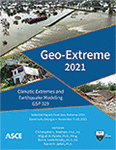Changes in Liquefaction Severity in the San Francisco Bay Area with Sea-Level Rise
Publication: Geo-Extreme 2021
ABSTRACT
This paper studies the impacts of sea-level rise on liquefaction triggering and severity around the San Francisco Bay Area, California, for the M 7.0 “HayWired” earthquake scenario along the Hayward fault. This work emerged from stakeholder engagement for the US Geological Survey releases of the HayWired earthquake scenario and the Coastal Storm Modeling System projects, in which local planners and engineers asked where, why, and by how much liquefaction hazards may change due to sea-level rise in the future. We assess the impacts of sea-level rise on liquefaction by computing changes in liquefaction potential index (LPI) for over 400 cone penetration test (CPT) soundings around the San Francisco Bay for groundwater table models developed for current and increased sea levels of up to 5 m. For the M 7.0 HayWired earthquake scenario, we find that while the majority of sites are insensitive to sea-level changes of less than 1 m, some sites are highly sensitive to small changes in water levels. We then repeat these analyses for a uniform shaking scenario to isolate the effects of sea-level rise and we find similar patterns of change. For both earthquake scenarios, modest changes in overall LPI are expected for increases in sea level, but individual sites may see significant increases in liquefaction likelihood and severity.
Get full access to this article
View all available purchase options and get full access to this chapter.
REFERENCES
Bardet, J. P., and Kapuskar, M. (1993). “Liquefaction sand boils in San Francisco during 1989 Loma Prieta earthquake”. Journal of Geotechnical Engineering, 119(3), 543–562.
Befus, K. M., Barnard, P. L., Hoover, D. J., Hart, J. F., and Voss, C. I. (2020). “Increasing threat of coastal groundwater hazards from sea-level rise in California”. Nature Climate Change, 10(10), 946–952.
Boulanger, R. W., and Idriss, I. M. (2016). “CPT-based liquefaction triggering procedure”. Journal of Geotechnical and Geoenvironmental Engineering, 142(2), 04015065.
Church, J. A., et al. in Climate Change 2013: The Physical Science Basis (eds Stocker, T. F. et al.) 1137–1216 (IPCC, Cambridge Univ. Press, 2013).
Detweiler, S. T., and Wein, A. M., eds. (2017). “The HayWired earthquake scenario” U.S. Geological Survey Scientific Investigations Report 2017–5013, https://doi.org/10.3133/sir20175013.
Holzer, T. L., ed., (1998). The Loma Prieta, California, earthquake of October 17, 1989 – Liquefaction: U.S. Geological Survey Professional Paper 1551-B, 314 p. http://pubs.usgs.gov/pp/pp1551/pp1551b/.
Holzer, T. L., Bennett, M. J., Noce, T. E., Padovani, A. C., and Tinsley, J. C., III. (2002). “Liquefaction hazard and shaking amplification maps of Alameda, Berkeley, Emeryville, Oakland, and Piedmont: A digital database” U.S. Geological Survey Open-File Report 02-296. http://pubs.usgs.gov/of/2002/of02-296/.
Holzer, T. L., Bennett, M. J., Noce, T. E., Padovani, A. C., and Tinsley, J. C., III. (2006). “Liquefaction hazard mapping with LPI in the greater Oakland, California, area”. Earthquake Spectra, 22(3), 693–708.
Holzer, T. L., Noce, T. E., and Bennett, M. J. (2009). “Scenario liquefaction hazard maps of Santa Clara Valley, northern California”. Bulletin of the Seismological Society of America, 99(1), 367–381.
Iwasaki, T., Tatsuoka, F., Tokida, K.-I., and Yasuda, S. (1978). “A practical method for assessing soil liquefaction potential based on case studies at various sites in Japan”, in Proceedings of the 2nd International conference on microzonation, San Francisco, p. 885–896.
Jones, J. L., Knudsen, K. L, and Wein, A. M. (2017). “HayWired Scenario Mainshock—Liquefaction Probability Mapping” Chapter E in The HayWired Earthquake Scenario—Earthquake Hazards, Detweiler S. T., and Wein, A. M., eds. U.S. Geolgical Survey Scientific Investigations Report 2017–5013–A–H https://doi.org/10.3133/sir20175013.
Lees, J. J., Ballagh, R. H., Orense, R. P., and Van Ballegooy, S. (2015). “CPT-based analysis of liquefaction and re-liquefaction following the Canterbury earthquake sequence”. Soil Dynamics and Earthquake Engineering, 79, 304–314.
Lenz, J. A., and Baise, L. G. (2007). “Spatial variability of liquefaction potential in regional mapping using CPT and SPT data”. Soil Dynamics and Earthquake Engineering, 27(7), 690–702.
Maurer, B. W., Green, R. A., and Taylor, O. D. S. (2015). “Moving towards an improved index for assessing liquefaction hazard: lessons from historical data”. Soils and Foundations, 55(4), 778–787.
Monk, C. B., Van Ballegooy, S., Hughes, M., and Villeneuve, M. (2016). “Liquefaction vulnerability increase at North New Brighton due to subsidence, sea level rise and reduction in thickness of the non-liquefying layer”. Bulletin of the New Zealand Society for Earthquake Engineering, 49(4), 334–340.
Risken, J. L., Fraser, J. G., Rutter, H., and Gadsby, M. (2015). “Implications of sea level rise on liquefaction vulnerability in Christchurch”. In 6th International Conference on Earthquake Geotechnical Engineering, Christchurch (pp. 1–4).
Robertson, P. K., and Wride, C. E. (1998). “Evaluating cyclic liquefaction potential using the cone penetration test”. Canadian Geotechnical Journal, 35(3), 442–459.
Rotzoll, K., and Fletcher, C. H. (2013). “Assessment of groundwater inundation as a consequence of sea-level rise”. Nature Climate Change, 3, 477–481.
Tinsley, J. C., III, Egan, J. A., Kayen, R. E., Bennett, M. J., Kropp, A., and Holzer, T. L. (1998). “Appendix—Maps and descriptions of liquefaction and associated effects, in Holzer, T. L., ed., The Loma Prieta, California, Earthquake of October 17, 1989—Liquefaction” U.S. Geological Survey Professional Paper 1551–B.
Toprak, S., and Holzer, T. L. (2003). “Liquefaction potential index: Field assessment” Journal of Geotechnical and Geoenvironmental Engineering, 129(4), 315–322.
Yasuhara, K., Murakami, S., Mimura, N., Komine, H., and Recio, J. (2007). “Influence of global warming on coastal infrastructural instability”. Sustainability Science, 2(1), 13–25.
Yasuhara, K., Komine, H., Murakami, S., Chen, G., Mitani, Y., and Duc, D. M. (2012). “Effects of climate change on geo-disasters in coastal zones and their adaptation”. Geotextiles and Geomembranes, 30, 24–34.
Youd, T. L., and Hoose, S. N. (1978). “Historical Ground Failures in Northern California Triggered by Earthquakes”.
Information & Authors
Information
Published In
Copyright
© 2021 American Society of Civil Engineers.
History
Published online: Nov 4, 2021
Authors
Metrics & Citations
Metrics
Citations
Download citation
If you have the appropriate software installed, you can download article citation data to the citation manager of your choice. Simply select your manager software from the list below and click Download.
